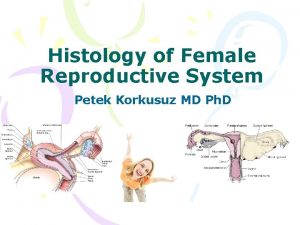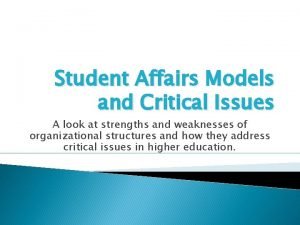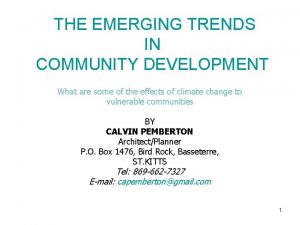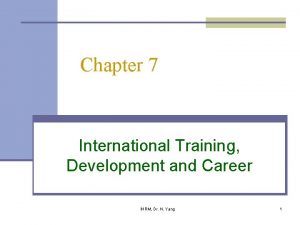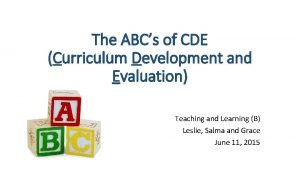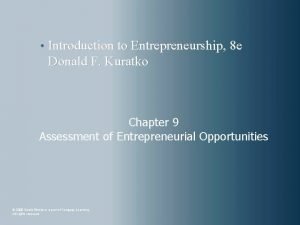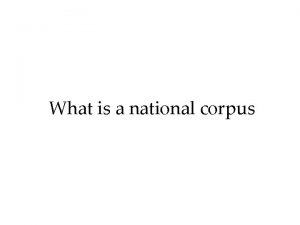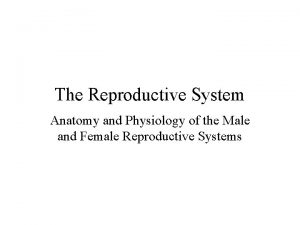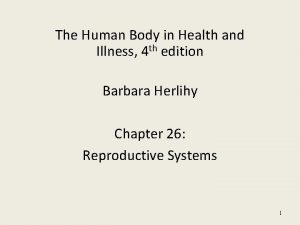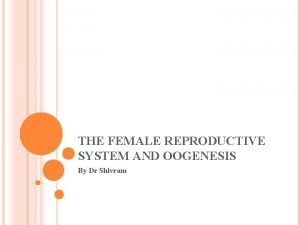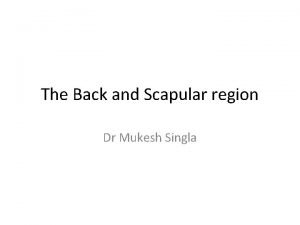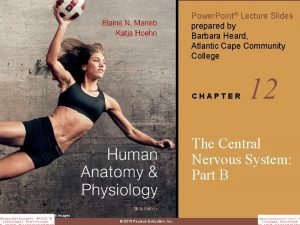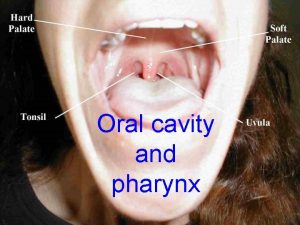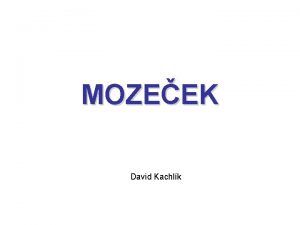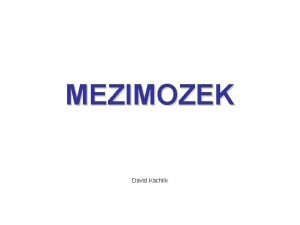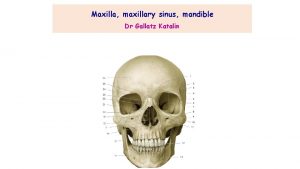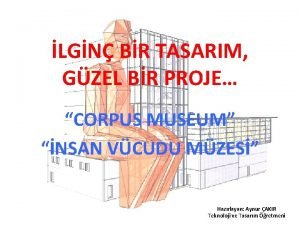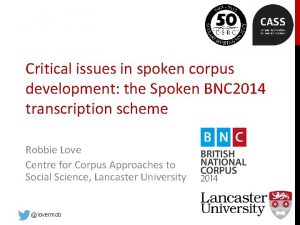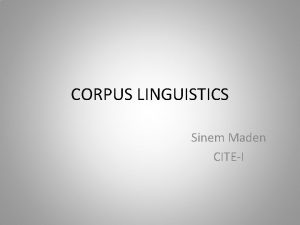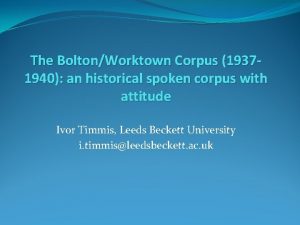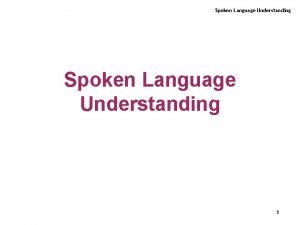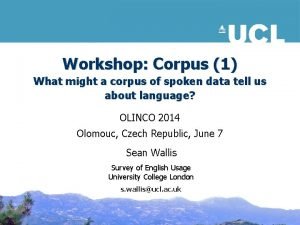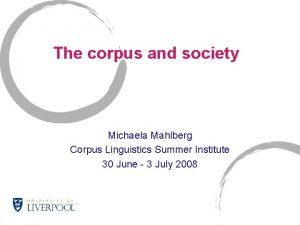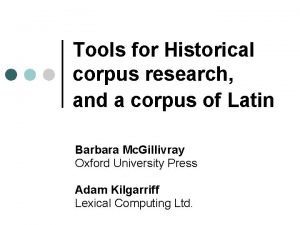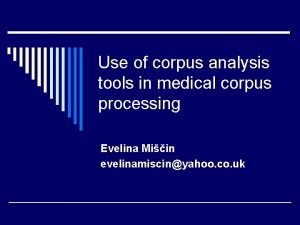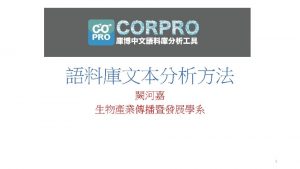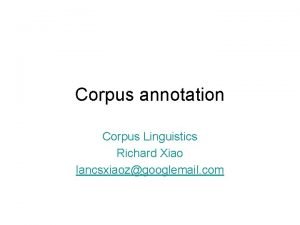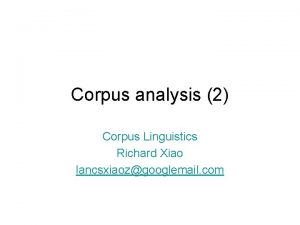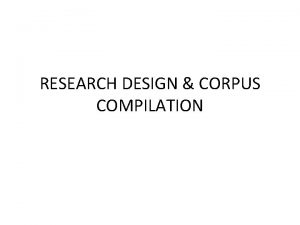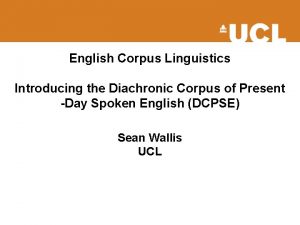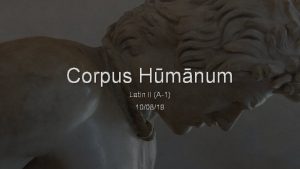Critical issues in spoken corpus development the Spoken































































- Slides: 63

Critical issues in spoken corpus development: the Spoken BNC 2014 transcription scheme and speaker identification Robbie Love CASS, Lancaster University @lovermob

Today’s talk • The BNC • The Spoken BNC 2014 • Progress so far – pilot study + current work (1) Transcription scheme development (2) Speaker identification • Conclusions • Next steps @lovermob http: //cass. lancs. ac. uk

Some history: the BNC (1994) “a corpus of 100 million words of written texts and spoken transcriptions of modern British English, to be stored on the computer in machine-readable form” Leech (1993: 9) • British publishers: Oxford University Press, Longman, Chambers • Plus Oxford University and Lancaster University @lovermob http: //cass. lancs. ac. uk

Some history: the BNC (1994) • BNC used to produce over 200 journal articles (over 100 published after 2009) • Open-access, hosted online by various institutions: – Brigham Young University (BNC-BYU) – University of Zurich (BNCweb World Edition) – Lancaster University (BNCweb) @lovermob http: //cass. lancs. ac. uk

Some history: the BNC (1994) • Spoken component = 10 million words • Demographic (c. 40%) and context-governed data (c. 60%) (see Aston and Burnard 1997) “an immense collection of conversational data, systematically sampled across the whole population of the UK…a comprehensive and carefully sampled record of how the language is used in living speech” (Leech 1993: 14) @lovermob http: //cass. lancs. ac. uk

Some history: the BNC (1994) • It’s getting old • Can no longer be used as a proxy for present day British English • Nothing since the Spoken BNC (1994): - large size - general coverage of spoken British English - (low or no cost) public access - transcribed @lovermob http: //cass. lancs. ac. uk

The BNC 2014 @lovermob http: //cass. lancs. ac. uk

The Spoken BNC 2014 • CASS and Cambridge University Press • 10 million words spontaneous conversation (demographic data) • First of its kind since the original Spoken BNC (1994) @lovermob http: //cass. lancs. ac. uk

People • • Claire Dembry Laura Grimes Samantha Owen 13 transcribers @lovermob • • Tony Mc. Enery Andrew Hardie Vaclav Brezina Robbie Love http: //cass. lancs. ac. uk

The Spoken BNC 2014 • See Dembry and Love (2015) for overview of methodology Some highlights: • Members of the public commissioned as freelancers to make unsupervised recordings • Smartphones (vs. analogue tape recorders) • Non-surreptitious! • 13 freelance transcribers • Only demographic (for now) @lovermob http: //cass. lancs. ac. uk

The Spoken BNC 2014 Both parties • Fund project equally • Encourage participation – media campaigns • Disseminate information CUP • Corresponds with contributors • Collects recordings • Transcribes data CASS • Carries out methodological investigations • Converts transcripts to XML, encoding • Annotates corpus • Initial analysis • Prepares for public release/hosts finished corpus @lovermob http: //cass. lancs. ac. uk

The Spoken BNC 2014 Progress report • 4 million words transcribed • Average 140, 000 words per week • 373 recordings submitted • 300 hours submitted • 367 speakers so far and counting @lovermob http: //cass. lancs. ac. uk

The Lancaster pilot study (Love 2014) • Investigation of several methodological issues in the compilation of spoken corpora – informing practice in the Spoken BNC 2014 – Design and metadata – Recording – Transcription • developing the scheme • Speaker identification • Simultaneous to the Cambridge pilot study (Dembry) http: //cass. lancs. ac. uk

The Lancaster pilot study (Love 2014) The Spoken BNC 2014 pilot corpus • 5. 5 hours of audio data • Replicated the style of recordings in the Spoken BNC 2014 • 14 recordings, 32 speakers, 47, 000 words, 6, 552 turns • Transcribed by two full-time, professional transcribers at CASS http: //cass. lancs. ac. uk

Transcription scheme development • Crowdy (1994) – original BNC scheme • Gablasova et al. (under review) – Trinity Lancaster Corpus • Atkins et al. (1992) – corpus design criteria • Hasund (1998) – anonymization guidelines • Consultation with CASS transcribers • Claire Dembry’s work at Cambridge (2012 -) • Discussion between CASS and CUP • Hardie (2014) - XML @lovermob http: //cass. lancs. ac. uk

Why not simply reuse the original? Crowdy (1994) “Spoken Corpus Transcription” Generally, it’s pretty good, but: • 16 features identified in the 1, 900 word scheme – very few examples • Not enough clarity in some areas, leading to ambiguity • Compatibility with CASS XML standards for automatic conversion @lovermob http: //cass. lancs. ac. uk

Why not simply reuse the original? EXAMPLE #1 • Question marks to indicate questioning utterances <1> It’s a funny old day isn’t it. <2> Mm it’s not cold is it? Crowdy (1994: 28) @lovermob http: //cass. lancs. ac. uk

Why not simply reuse the original? EXAMPLE #2 • using full stops and commas to “approximate to use in written text”, but also indicating pauses with ellipses <2> I think it’s always, deceptive on days like this because its, overcast and [er] […] <2> But, but er, he’s…just broken away from his girlfiend and [<unclear>] <1> [Oh has] he, oh. Well he seemed happy enough when he called. Crowdy (1994: 28) @lovermob http: //cass. lancs. ac. uk

Trinity Lancaster corpus scheme • Transcription scheme for the Trinity Lancaster Spoken Learner Corpus (Gablasova et al. under review) • One-to-one, examiner-student conversations • But major advantage of modernity, CASScompatibility and success in Trinity Lancaster project @lovermob http: //cass. lancs. ac. uk

Trinity Lancaster corpus scheme • Started with Gablasova et al. ’s scheme • Adapted according to – Crowdy (1994), and – Atkins et al. (1992: 11 -12), who provide a nice and still useful set of recommended considerations @lovermob http: //cass. lancs. ac. uk

Revising the Trinity Lancaster scheme Encoding of speaker IDs • Speakers assigned unique numeric label (Crowdy 1994) <1> It’s a funny old day isn’t it. <2> Mm it’s not cold is it? Crowdy (1994: 28) @lovermob http: //cass. lancs. ac. uk

Revising the Trinity Lancaster scheme Anonymization • Omit “any reference that would allow an individual to identified” (Crowdy 1994) • NOT automatically (Hasund 1998) • Hasund: Bank of English includes gender in anonymization tag e. g. I bumped into <name female> yesterday (+ male, neutral) @lovermob http: //cass. lancs. ac. uk

Revising the Trinity Lancaster scheme Overlaps • Crowdy’s (1994) rather complicated system: <1> So she was virtually a [a house prisoner] <2> [house {bound}] <3> {prisoner} • Not in Trinity Lancaster scheme • Decision to retain omission @lovermob http: //cass. lancs. ac. uk

Revising the Trinity Lancaster scheme Punctuation • Too much room for interpretation in Crowdy (1994) • Like Trinity Lancaster corpus, all syntactic punctuation stripped, apart from question marks for fully formed interrogative structures – yes/no questions – wh-questions – tag questions @lovermob http: //cass. lancs. ac. uk

Revising the Trinity Lancaster scheme Quotative speech • Not in Atkins et al. (1992), Crowdy (1994) or Trinity Lancaster scheme • Proposal: <1> he said <quot> I’ll see you later </quot> • Could this be added to scheme with minimal time addition? @lovermob http: //cass. lancs. ac. uk

Pilot with CASS transcribers • Tested in the transcription of the Spoken BNC 2014 pilot corpus • Consultation with the CASS transcribers, who were also the transcribers on the Trinity Lancaster project • Further changes made in reflection @lovermob http: //cass. lancs. ac. uk

Pilot with CASS transcribers Anonymization • Of the 380 <name> tags, only 1. 8% not coded for gender @lovermob http: //cass. lancs. ac. uk

Pilot with CASS transcribers Question marks • Crowdy (1994) criticised for being too loose with this • However CASS transcribers wanted more than fully formed interrogatives • Trusted to use intuitive criteria instead, e. g. <3> ah is it lovely and warm there Dylan? getting dried off? <? > how many years have we lived here? two and a half years? @lovermob http: //cass. lancs. ac. uk

Pilot with CASS transcribers Quotative content • CASS transcribers reported no problems • But, e. g. , only 35/75 instances of said + direct reported speech actually tagged • Therefore removed from scheme @lovermob http: //cass. lancs. ac. uk

Review with Cambridge • Resulting scheme sent to CUP to ‘merge’ with scheme used so far by their team • Features added that were not considered by previous Lancaster investigations but deemed worthy of inclusion – filled pauses – non-English speech – pauses – events @lovermob http: //cass. lancs. ac. uk

Resulting scheme • From 1, 900 words to 5, 000 words! • Lots of examples • (Hopefully) minimal room for ambiguity = maximal room for inter-rater consistency @lovermob http: //cass. lancs. ac. uk

The bird’s eye view SPOKEN BNC (1994) Speaker turns Overlapping speech Use of punctuation, and 'sentence' boundaries SPOKEN BNC 2014 Speaker IDs Overlaps Punctuation – question marks Utterances Unfinished words (false starts) Pauses and events Vocalised pauses Pauses and events Accent, dialect, and representation of Nonstandard words or sounds nonstandard forms Nonstandard contractions or shortenings Native speaker accent/dialect Paralinguistic features Non-verbal sounds Pauses and events Non-linguistic vocalisations Contextual comments Unclear or inaudible text Pauses and events Unintelligible speech/guesses Unfamiliar words Unintelligible speech/guesses Spelt-out words Acronyms/spelling/capitalisation Acronyms and abbreviations Acronyms/spelling/capitalisation Telephone conversations Codes used to preserve anonymity Pauses and events Anonymization Text read out Pauses and events @lovermob http: //cass. lancs. ac. uk EXTRA SPOKEN BNC 2014 General guidelines Document format Line height and spacing Header information Tag format Non-English speech Numbers

The bird’s eye view • Delicate balance sought between – backwards compatibility, and – optimal practice • Similar enough to compare with original • Different enough to be better @lovermob http: //cass. lancs. ac. uk

e. Xtensible Markup Language (XML) • Makes possible for automated mapping to standard XML, with minimal manual editing • Original Spoken BNC was not initially in XML, but later converted, therefore comparable • But even in XML it adheres to the highly complex Text Encoding Initiative (TEI) • So we’re using Hardie’s (2014) “Modest XML for Corpora” “any linguist from the level of a bright undergraduate upwards should be able to understand it” @lovermob http: //cass. lancs. ac. uk (p. 79)

A fresh problem • Quality control traditionally focusses on accuracy of transcription • Spoken BNC 2014 is no exception – audiochecking and proofreading procedures in place at Cambridge • However…a fresh problem arose in the Lancaster pilot study @lovermob http: //cass. lancs. ac. uk

Speaker identification = who said that? • has no bearing on the accuracy of the transcription of linguistic content itself (i. e. what was said), but refers to the identification of the speaker that produced the transcribed turn (i. e. who said it) @lovermob http: //cass. lancs. ac. uk

Speaker identification • There are two unavoidable deficiencies in the transcription of audio recordings: transcribers’ lack of familiarity with (i) the speakers and (ii) the context in which the conversations occurred @lovermob http: //cass. lancs. ac. uk

Major assumption Speaker identification not an issue • when there are only two speakers; or, • when the speakers have highly contrasting voice qualities; or, • when the transcriber knows the speakers in the recording, and can recognise their voices. @lovermob http: //cass. lancs. ac. uk

Major assumption Speaker identification is likely an issue • when there are several speakers, and/or • when the differences in voice quality between two or more speakers are not be sufficient to tell them apart @lovermob http: //cass. lancs. ac. uk

Importance of speaker identification • Speaker ID codes link to demographic metadata • Corpus-based sociolinguistics is already controversial – aggregate data “random (and therefore sociolinguistically irrelevant) speaker groupings can often yield statistically significant results” Brezina & Meyerhoff (2014) @lovermob http: //cass. lancs. ac. uk

Pilot study (Love 2014) • Pilot #1 = the Spoken BNC 2014 pilot corpus – certainty • Pilot #2 = legitimate Spoken BNC 2014 recording – certainty – inter-rater agreement with original transcript @lovermob http: //cass. lancs. ac. uk

Pilot #1 = certainty in the Spoken BNC 2014 pilot corpus • 5. 5 hours of audio data • Replicated the style of recordings in the Spoken BNC 2014 • 14 recordings, 32 speakers, 47, 000 words, 6, 552 turns • Transcribed by two full-time, professional transcribers at CASS @lovermob http: //cass. lancs. ac. uk

Certainty (the pilot corpus) Speaker identification action Example % of turns in pilot study speaker ID code recordings Mark turn with speaker ID code <022> 68. 31 Mark turn with ‘best guess’ speaker ID code <022? > 6. 26 Mark turn as indeterminable <? > 25. 43 • Certainty a majority, but 25% indeterminable • No. of speakers? @lovermob http: //cass. lancs. ac. uk

Certainty (the pilot corpus) 100 90 80 70 60 50 40 30 20 10 0 2 3 4 5 8 Average % indeterminable Linear trendline @lovermob http: //cass. lancs. ac. uk 9 10 12

Pilot #2 = certainty and inter-rater agreement in a legitimate Spoken BNC 2014 recording • An example of the most difficult circumstance in the Spoken BNC 2014 itself • 9 speakers • 1, 080 turns • 9, 871 words • Spoken BNC 2014 transcript compared with two CASS transcribers’ versions • One used ‘best guess’, one didn’t @lovermob http: //cass. lancs. ac. uk

Certainty (legitimate Spoken BNC 2014 recording) Speaker identification action Example speaker ID code Mark turn with speaker ID code <022> 94. 35 18. 06 70. 09 Mark turn with ‘best guess’ speaker ID code <022? > 0. 28 42. 78 0. 00 Mark turn as indeterminable <? > 5. 37 35. 56 23. 70 Not coded N/A 0. 00 3. 61 6. 20 @lovermob % of turns in Spoken BNC 2014 transcript % turns in CASS transcriber version #1 http: //cass. lancs. ac. uk % turns in CASS transcriber version #2

Certainty (legitimate Spoken BNC 2014 recording) • Was the original transcriber really as certain as the transcript implies? • Speaker identity in this recording appears to be far from clear • What about inter-rater agreement? • 1, 019 turns in original transcript had speaker ID codes @lovermob http: //cass. lancs. ac. uk

Inter-rater agreement (legitimate Spoken BNC 2014 recording) % turns in CASS transcriber version #1 Type of match Match Non-match @lovermob % turns in CASS transcriber version #2 Exact 15. 09 38. 55 Best guess 17. 54 N/A Wrong code 32. 16 35. 77 Indeterminable 35. 21 25. 67 http: //cass. lancs. ac. uk

Inter-rater agreement (legitimate Spoken BNC 2014 recording) • When code given (i. e. ignoring indeterminable codes) chance of matching only just over half • However, 99. 4% of wrong codes at least got the gender right • So, in BNC 2014 transcription scheme, indeterminable replaced with minimum gender code (i. e. <M> or <F>) @lovermob http: //cass. lancs. ac. uk

Current work • Speaker identification could be an problem worth paying attention to • Further investigation needed, within a reasonable limit • ‘Speaker-heavy’ recordings = 20% of Spoken BNC 2014 so far • ASSUMPTION: this is not a problem for 2 -, 3 -, 4 -speaker recordings – to be checked! @lovermob http: //cass. lancs. ac. uk

Current work • Assessing the actual Spoken BNC 2014 transcribers (rather than CASS transcribers) • Replicating pilot work on Spoken BNC 2014 transcribers, plus: • Is there a ‘gold standard’? • Can one be manufactured illegitimately? @lovermob http: //cass. lancs. ac. uk

Current work • Investigation #1 = legitimate Spoken BNC 2014 recording - certainty - inter-rater agreement with original transcript • Investigation #2 = fake gold standard recording - accuracy @lovermob http: //cass. lancs. ac. uk

Investigation #1 = certainty and inter-rater agreement in a legitimate Spoken BNC 2014 recording • 6 speakers, 32 minutes, 587 turns, 6, 862 words • Original transcript + 6 ‘test’ transcripts • Average proportion of definite ID codes versus indefinite ID codes • Agreement on coding of specific ID codes between transcripts @lovermob http: //cass. lancs. ac. uk

Investigation #2 = accuracy in a fake gold standard recording • 8 speakers, 25 minutes, 775 turns, 4, 886 words • My transcript (‘gold standard’) + 8 ‘test’ transcripts • Same as inter-rater agreement test, but we can call this accuracy @lovermob http: //cass. lancs. ac. uk

Preparing the data • Both investigations asked the Spoken BNC 2014 transcribers to transcribe the recordings from scratch • #1 was done ‘blind’; #2 was done explicitly • In both cases, transcripts had to be manually aligned @lovermob http: //cass. lancs. ac. uk

Current work: overview #1 CERTAINTY #1 AGREEMENT ESTIMATION OF ‘SPEAKER-HEAVY’ ACCURACY IN SPOKEN BNC 2014 @lovermob http: //cass. lancs. ac. uk #2 ACCURACY

Investigation #1 – findings so far • Total 587 turns to compare Speaker identification action Example speaker ID code % of turns in Spoken % turns in test BNC 2014 transcripts Mark turn with speaker ID code <022> 98. 30 80. 99 Mark turn with ‘best guess’ speaker ID code <022? > 1. 53 0. 56 Mark turn with gender <F> 0. 17 1. 17 • Not yet aligned – so some transcripts have more turns than original @lovermob http: //cass. lancs. ac. uk

Investigation #2 – findings so far • 775 turns considered across all 8 speakers Transcriber @lovermob % accurate speaker ID T 01 38. 87 T 02 65. 56 T 03 51. 24 T 04 34. 88 T 05 76. 99 T 06 31. 95 T 07 70. 45 T 08 58. 62 AVERAGE 53. 57 http: //cass. lancs. ac. uk

Investigation #2 – findings so far • 775 turns considered across all 8 speakers Speaker No. turns considered per speaker % accurate speaker ID (all transcribers) S 01 122 72. 44 S 02 59 33. 90 S 03 62 21. 57 S 04 107 57. 13 S 05 115 55. 98 S 06 110 83. 52 S 07 79 33. 54 S 08 121 70. 45 775 (total) 53. 57 (average) @lovermob http: //cass. lancs. ac. uk

Speaker identification – conclusions so far • Variation between transcribers in certainty over same recording (Spoken BNC 2014 transcript) • Accuracy in gold standard only just over 50%, proving difficulty of this @lovermob http: //cass. lancs. ac. uk

Next steps • Transcription development – Transcribe the rest and monitor audiochecking/proofreading procedure • Speaker identification – Check that ‘speaker-light’ recordings (c. 80% of corpus) are not affected by this problem – Put appropriate warning label on finished corpus, ability to exclude ‘high risk’ recordings – Argue that this is worth paying attention to – Historical assessment of implications for previous spoken corpora/research @lovermob http: //cass. lancs. ac. uk

Participate! • Data collection is ongoing corpus@cambridge. org @lovermob http: //cass. lancs. ac. uk

References • • Aston, G. & Burnard, L. 1997. The BNC handbook. Exploring the BNC with SARA. Edinburgh: Edinburgh University Press. Atkins, A. , Clear, J. , & Ostler, N. (1992). Corpus Design Criteria. Literary and Linguistic Computing, 7(1), 1 -16. Brezina, V. , & Meyerhoff, M. (2014). Significant or random? A critical review of sociolinguistic generalisations based on large corpora. International Journal of Corpus Linguistics, 19(1), 1 -28. doi: 10. 1075/ijcl. 19. 1. 01 bre Crowdy, S. (1994). Spoken Corpus Transcription. Literary and Linguistic Computing, 9(1), 25 -28. Gablasova, D. , Brezina, V. , Mc. Enery, T. & Boyd, E. (under review) Epistemic stance in spoken L 2 English: The effect of task type and speaker style, submitted to Applied Linguistics. Hardie, A. (2014). Modest XML for corpora: not a standard, but a suggestion. ICAME Journal, 38, 73 -103. Leech, G. (1993). 100 million words of English Today, 9 -15. doi: 10. 1017/S 0266078400006854 @lovermob http: //cass. lancs. ac. uk
 Critical semi critical and non critical instruments
Critical semi critical and non critical instruments Semi critical
Semi critical Oogenesis
Oogenesis English
English Critical issues in student affairs
Critical issues in student affairs Critical reading meaning
Critical reading meaning Trends in community development
Trends in community development International training career
International training career Importance of curriculum development
Importance of curriculum development Critical factors for new venture development
Critical factors for new venture development Hát kết hợp bộ gõ cơ thể
Hát kết hợp bộ gõ cơ thể Lp html
Lp html Bổ thể
Bổ thể Tỉ lệ cơ thể trẻ em
Tỉ lệ cơ thể trẻ em Chó sói
Chó sói Tư thế worm breton
Tư thế worm breton Bài hát chúa yêu trần thế alleluia
Bài hát chúa yêu trần thế alleluia Kể tên các môn thể thao
Kể tên các môn thể thao Thế nào là hệ số cao nhất
Thế nào là hệ số cao nhất Các châu lục và đại dương trên thế giới
Các châu lục và đại dương trên thế giới Công thức tính độ biến thiên đông lượng
Công thức tính độ biến thiên đông lượng Trời xanh đây là của chúng ta thể thơ
Trời xanh đây là của chúng ta thể thơ Mật thư anh em như thể tay chân
Mật thư anh em như thể tay chân 101012 bằng
101012 bằng Phản ứng thế ankan
Phản ứng thế ankan Các châu lục và đại dương trên thế giới
Các châu lục và đại dương trên thế giới Thơ thất ngôn tứ tuyệt đường luật
Thơ thất ngôn tứ tuyệt đường luật Quá trình desamine hóa có thể tạo ra
Quá trình desamine hóa có thể tạo ra Một số thể thơ truyền thống
Một số thể thơ truyền thống Cái miệng nó xinh thế chỉ nói điều hay thôi
Cái miệng nó xinh thế chỉ nói điều hay thôi Vẽ hình chiếu vuông góc của vật thể sau
Vẽ hình chiếu vuông góc của vật thể sau Thế nào là sự mỏi cơ
Thế nào là sự mỏi cơ đặc điểm cơ thể của người tối cổ
đặc điểm cơ thể của người tối cổ V. c c
V. c c Vẽ hình chiếu đứng bằng cạnh của vật thể
Vẽ hình chiếu đứng bằng cạnh của vật thể Fecboak
Fecboak Thẻ vin
Thẻ vin đại từ thay thế
đại từ thay thế điện thế nghỉ
điện thế nghỉ Tư thế ngồi viết
Tư thế ngồi viết Diễn thế sinh thái là
Diễn thế sinh thái là Các loại đột biến cấu trúc nhiễm sắc thể
Các loại đột biến cấu trúc nhiễm sắc thể Các số nguyên tố là gì
Các số nguyên tố là gì Tư thế ngồi viết
Tư thế ngồi viết Lời thề hippocrates
Lời thề hippocrates Thiếu nhi thế giới liên hoan
Thiếu nhi thế giới liên hoan ưu thế lai là gì
ưu thế lai là gì Hổ đẻ mỗi lứa mấy con
Hổ đẻ mỗi lứa mấy con Khi nào hổ con có thể sống độc lập
Khi nào hổ con có thể sống độc lập Sơ đồ cơ thể người
Sơ đồ cơ thể người Từ ngữ thể hiện lòng nhân hậu
Từ ngữ thể hiện lòng nhân hậu Thế nào là mạng điện lắp đặt kiểu nổi
Thế nào là mạng điện lắp đặt kiểu nổi Armenian national corpus
Armenian national corpus Layers of endometrium
Layers of endometrium Birth canal is formed
Birth canal is formed Oogenesis diagram
Oogenesis diagram Protracted scapula
Protracted scapula White fiber tracts
White fiber tracts Cavitas oris
Cavitas oris Infundibulum diencephalon
Infundibulum diencephalon Pedunculi cerebellaris inferior
Pedunculi cerebellaris inferior Metathalamus
Metathalamus Alveolar process of mandible
Alveolar process of mandible Corpus museum amsterdam
Corpus museum amsterdam



